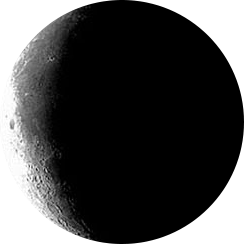Curious about the Moon phases for this month and next? Here are upcoming dates and times for each phase through the end of 2025. Please visit our Zodiac Calendar to see the Moon’s zodiac sign, which changes every 2-3 days on average.
| Moon Phases Calendar 2025 | ||
|---|---|---|
| Date | Moon Phase | Time (EST/EDT) |
| September 7 | Full Corn Moon (Lunar Eclipse) | 2:09 PM |
| September 14 | Last Quarter Moon | 6:33 AM |
| September 21 | New Moon (Partial Solar Eclipse) | 3:54 PM |
| September 29 | First Quarter Moon | 7:54 PM |
| October 6 | Full Harvest Moon – Supermoon | 11:48 PM |
| October 13 | Last Quarter Moon | 2:13 PM |
| October 21 | New Moon | 8:25 AM |
| October 29 | First Quarter Moon | 12:21 PM |
| November 5 | Full Beaver Moon – Supermoon | 8:19 AM |
| November 12 | Last Quarter Moon | 12:28 AM |
| November 20 | New Moon | 1:47 AM |
| November 28 | First Quarter Moon | 1:59 AM |
| December 4 | Full Cold Moon – Supermoon | 6:14 PM |
| December 11 | Last Quarter Moon | 3:52 PM |
| December 19 | New Moon | 8:43 PM |
| December 27 | First Quarter Moon | 2:10 PM |

Waning Crescent
16% of Full
Any questions? Contact [email protected]
Moon Phases Explained
Over the course of the month, the Moon displays different phases. There are eight distinct phases that appear (and repeat in a cycle) in the following order:
- New Moon (usually invisible)
- Waxing Crescent Moon
- First Quarter (the right half of the Moon is illuminated)
- Waxing Gibbous Moon
- Full Moon
- Waning Gibbous Moon
- Last Quarter (the left half of the Moon is illuminated)
- Waning Crescent
What causes the different Moon phases?
The Moon phase you see depends on where the Moon is in its orbit around Earth. The Moon doesn’t actually change shape and it doesn’t generate light of its own; it reflects the Sun’s light like a gigantic mirror. (Fun fact: Light travels 93 million miles from the Sun, bounces off the surface of the Moon, and then travels another 240,000 miles to reach your eyes.)
When the Moon is between the Sun and Earth, it is usually invisible. This is called a “New Moon.” After a day or so, the Moon begins to pass the Sun in its orbit. As it does, its right side becomes a crescent Moon, as shown in the photo here:

The Moon continues to travel eastward in its orbit. As it does, its right side glows brighter over the course of the lunar month.
When the Moon has made one quarter (one-fourth) of its trip around the Earth, it reaches the “first quarter” phase. At this point, the Moon, and Earth form a right angle. In the days that follow, the Moon’s brightness continues growing, through the “waxing gibbous” phase, until it becomes full. Full Moons occur when the Moon is at the exact opposite side of the Earth as the Sun.
After the full Moon, the Moon is considered to be waning (diminishing in light). The Moon phases continue in reverse order, beginning with gibbous and ending with crescent. Then the cycle repeats again with the next New Moon.
The Moon is always illuminated from right to left over the course of the month. So if you happen to see a crescent on the right side, you know the Moon is waxing (heading towards a full Moon) and if you see a crescent on the left side, the Moon is waning (heading towards a New Moon phase).
The explanation above was provided by expert astronomer Dean Regas.
Join The Discussion
What are your favorite Moon phases?
Do you prefer a crescent Moon or a full Moon?
Have you used our Moon Phase Calendar to plan any activities?
Share with your community here in the comments below!


Both crescent moon and full moon are beautiful in their own right.
Moon phases
Where are the astrological signs for the lunar phases???
Here’s a link Carol – https://www.farmersalmanac.com/calendar/zodiac-calendar
When did the dark phase of the moon become the “new” moon, and why?
In prehistoric times.
they are right as far as the waxing ang waning but how do you tell what sign the moon is in?
Hi LaTanyia, You may be interested in this article about “new” Moons: https://www.farmersalmanac.com/when-is-the-next-new-moon
Lots of good information with lots of stuff that make you think!!
I remember ever since I was young my grandma mentioning that it’s a full moon so she’ll get her hair cut.There wasn’t a discussion about it yet I remember that being said. Now in my forties , finally I understand why . And I believe the reasonings behind it because it seemed to be true as well as planting and gardening which she again didn’t say detail but mentioned certain ways best to be done during certain moon types. I wish it soaked in more but that’s why I’m here is to talk and learn the true ways. I’m open to any advice to do with planting of plants ,flowers,trees, veg. gardening & transferring, etc. . Even hair trimming, cutting, coloring. Thank you all for reading my short book above LOL
Hi Corey! Yes, we are here to help you discover the “Best Days” to do everything. Here is our Daily Planner that lists suggestions for each day – https://www.farmersalmanac.com/calendar – If you have any questions, leave another comment!
when is the best time to dig potatoes?
Strangely, on certain days I would find myself in the garden mood either cleaning or planting..just so happens those days would sync in the calendar for whatever I planted! So most who know me have said that I have a green thumb! Isn’t that strange? 🤔
I love full moons, I’m so relaxed during this time, I do videos of the full moons, sent it to my bestie in Brockton Massachusetts, he said I have never heard you sound so relaxed before
🫶🌝🌚✌️
My Dad was a “moon person”. He loved to see the different phases of the moon and he enjoyed teaching all of us kids and his grandkids how beautiful it was. He also taught us some lore about moon phases. One I remember distinctly was about burying a potato skin if you had a toothache during a full moon phase. It actually works. Toothaches gone. No one in my family had severe tooth problems until they were in their latter years, if at all. It’s amazing. Sometimes those lore stories or old wives tales hold a lot of truth.
This is great – thank you for sharing this lore with us!